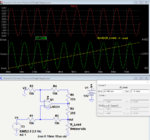mamech
Full Member level 3
Hello all
I want to convert a voltage signal to a current signal. when I searched I found this is the most simple topology that achieves this objective:
https://sub.allaboutcircuits.com/images/03039.png
it works very well with me, with only one draw back : the current signal is not referenced to the ground
and in my application I need the output current to be referenced to the same ground of opamp supply.
so I searched again, and I found this topology:
**broken link removed**
it works, but it is not accurate like the first method. for example, I used all resistors to be 255 ohms (including load resistor), and when I gave it 4.9 volts input, I got drop on load resistor around 4.56 volts.
Is not there a simple topology that is accurate like the first method, and referenced to ground like second method?
I want to convert a voltage signal to a current signal. when I searched I found this is the most simple topology that achieves this objective:
https://sub.allaboutcircuits.com/images/03039.png
it works very well with me, with only one draw back : the current signal is not referenced to the ground
and in my application I need the output current to be referenced to the same ground of opamp supply.
so I searched again, and I found this topology:
**broken link removed**
it works, but it is not accurate like the first method. for example, I used all resistors to be 255 ohms (including load resistor), and when I gave it 4.9 volts input, I got drop on load resistor around 4.56 volts.
Is not there a simple topology that is accurate like the first method, and referenced to ground like second method?
Last edited:
